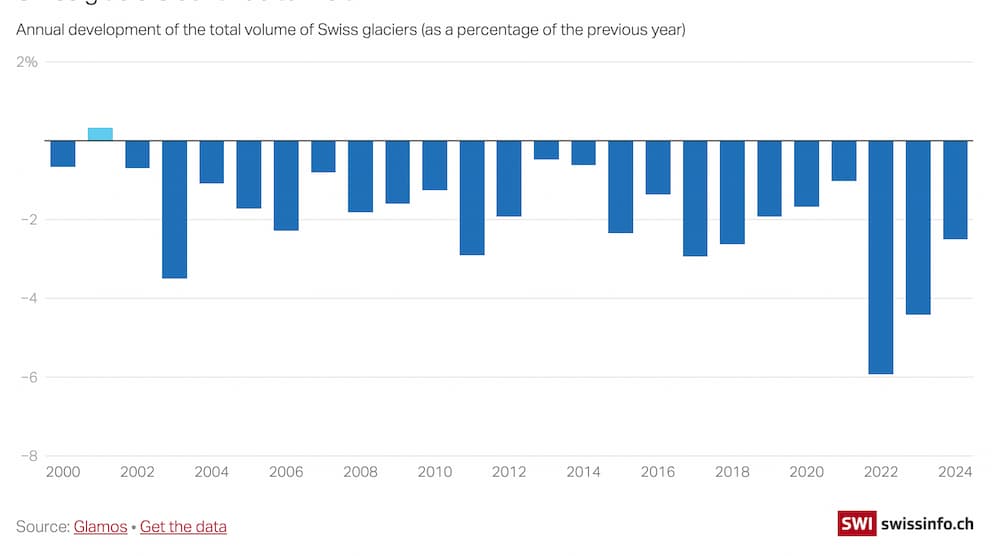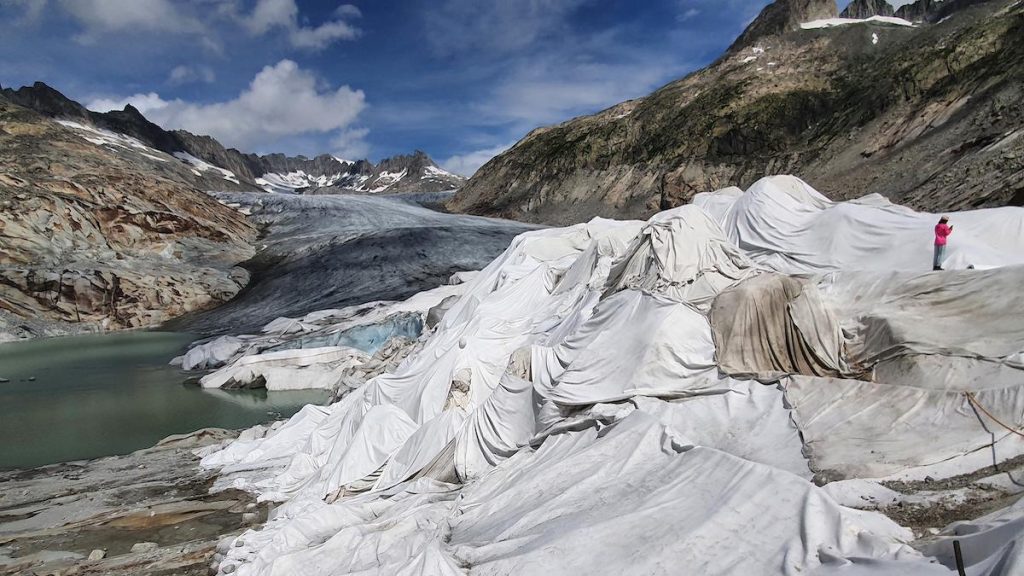Switzerland’s snowy peaks and bright blue glaciers are world famous, but they’re vanishing fast, and this is slowly ruining huge parts of the country!
Scientists say the country’s glaciers have been melting at record speed in just the last few years. The change is so dramatic that some mountain villages are now in danger from collapsing cliffs and landslides.
And, it can drastically affect your Switzerland visit with valley closures, crazy weather patterns and rising costs.
Glaciers in Switzerland Are Shrinking Faster Than Ever

Switzerland’s glaciers are disappearing at an alarming rate.
Between 1931 and 2016, Switzerland lost about half of all its glacier ice.
And since 2000, about 38% of the total glacier volume has vanished, dropping from roughly 75 cubic kilometers of ice to just 46.

The Aletsch Glacier, the largest in the Alps, shrinks by nearly 100 meters yearly. This massive loss is driven by hotter summers, shorter winters, and less snowfall.
Sources: Swissinfo.ch, SnowBrains, Swiss Academy of Sciences (GLAMOS)
Less Snow, Warmer Winters, and Changing Seasons

If you’ve noticed that photos of Switzerland look greener in winter, you’re not imagining it.
The average snowline has climbed 300 to 500 meters (same in yards) higher than 50 years ago.
Lower ski resorts are now struggling to keep snow on their slopes. Some areas have fewer than 40 snow days per season, forcing them to rely on artificial snow. But snowmaking only works when it’s cold enough, and winters are getting too warm.
The 2023–24 winter was one of Switzerland’s warmest ever. Many mountain towns below 1,200 meters saw rain instead of snow. Classic ski areas such as Grindelwald and Adelboden are feeling the effects, as their seasons get shorter and their costs rise.
Sources: MeteoSwiss, European Environment Agency
Melting Glaciers Are Changing the Land

The loss of ice changes the view, it changes the land itself. Melting glaciers initially send more water into rivers, but the flow will shrink when the ice is gone.
Want To Save This For Later?
This threatens hydropower, lakes, and water supplies during dry summers. So, you may have to save water during your visit, a surprise no one wants on a vacation!
The ground in the Alps is also becoming less stable. Frozen layers of soil and rock, called permafrost, used to hold mountains together.
As these layers thaw, the risk of landslides and rockfalls grows.
In 2024, the small village of Brienz in Graubünden had to be completely evacuated because the mountain above it began sliding toward the town at speeds of up to 35 centimeters per day.
Then, in May 2025, a huge rock and glacier collapse buried about 90% of the village of Blatten in the Lötschental valley. Nearly 10 million cubic meters of rock and ice crashed down, destroying homes and infrastructure.
Sources: Reuters, AP News, Le Monde
Tourism Is Feeling the Heat

Tourism is around 3% of Switzerland’s economy, and snow is one of its biggest attractions. But with less snow, many resorts are facing big challenges. The ski season is getting shorter, operating costs are rising, and visitors are looking for other experiences.
70% of low-altitude ski resorts could lose reliable snow cover if temperatures continue to rise.
Studies suggest that if temperatures continue to rise, up to 70% of low-altitude ski resorts could lose reliable snow cover by 2100.
Some mountain areas are adapting by focusing on year-round tourism by offering hiking, biking, spa retreats, and cultural events instead of relying only on skiing. This shift takes time and money, but it’s becoming essential for survival.
Sources: Swiss Tourism Federation, University of Bern
Switzerland’s Response: Protect and Adapt

Switzerland is taking action, but even strong measures can only slow the changes.
The government’s Net Zero 2050 plan aims to cut emissions almost completely. Some glaciers, such as the Rhone Glacier, are covered with white blankets during summer to reflect sunlight and reduce melting.
Tourism boards are encouraging eco-friendly travel — promoting train trips instead of car rentals, sustainable hotels, and climate education programs for visitors. Scientists are also expanding mountain monitoring systems to predict and warn residents about potential rockfalls and glacier collapses.
Sources: Federal Office for the Environment (FOEN), MySwitzerland – Sustainability Initiatives
A Melting Warning
Switzerland’s glaciers are melting faster than ever, and the impact is already here. Villages like Brienz and Blatten show that this is an environmental issue and a threat to lives, livelihoods, and national identity.
Without strong global action, the Alps could look very different by the end of this century. By traveling responsibly and spreading awareness, visitors can help protect one of the world’s most beautiful landscapes — before it melts away.


